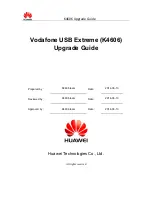
Wireless ADSL Modem User’s Manual
50
Wireless LAN (WLAN) Security
WiFi Protected Access (WPA)
security certification is a partial snapshot of 802.11i. It
includes Temporal Key Integrity Protocol (TKIP) and 802.1x mechanisms. The
combination of these two mechanisms provides dynamic key encryption and mutual
authentication,
With WPA, you can connect this modem with RADIUS server to perform 802.1x for
authentication. 802.1x is an IEEE standard that enables authentication and key
management for LANs. Although originally designed as a port authentication scheme for
wired networks, it has recently been applied to address some of the security issues
surrounding wireless LANs.
The use of IEEE 802.1x offers an effective framework for authenticating and
controlling user traffic to a protected network, as well as dynamically varying encryption
keys. 802.1x ties a protocol called EAP (Extensible Authentication Protocol) to both the
wired and wireless LAN media and supports multiple authentication methods, such as
Kerberos, token cards, one-time passwords, certificates, and public key authentication.
Port security provides another means to ensure that only authorized users are on the
network by limiting access based on MAC addresses. For authentication of users with a
RADIUS server, 802.1x provides port-level security.
Such RADIUS service allows you to authenticate clients with
802.1x
authentication.
It requires three roles in the authentication process: that of an supplicant, an
authenticator and an authentication server.
•
Supplicant
: WLAN users run an 802.1x client which supports a strong EAP
authentication method such as EAP-TTLS
•
Authenticator
: 802.1x compliant access points. See Appendix D as an example for how
to setup Cisco Aironet 350 as 802.1x AP.
•
Authentication server
: such as RADIUS server which supports a strong EAP
authentication methods such as EAP-TTLS. Examples are Windows 2000 Server with
IAS on, or FreeRadius server.
















































